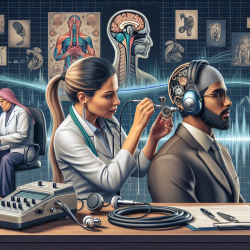The field of audiology is ever-evolving, with continuous advancements in technology and methodologies aimed at improving patient care. One area that has seen significant development is the use of computerized probe tube microphone systems in real ear measurements. The research paper "Current Issues In Probe Tube Microphone Measurements" by Marshall Chasin provides a comprehensive overview of the complexities and nuances involved in probe tube microphone measurements, highlighting areas that require attention for enhanced clinical outcomes.
Understanding the appropriate acoustic environment for testing, the reliability and validity of measurements, the transition region, the shape of the spectral stimulus, comparisons of real-time versus stored calibration techniques, and non-standard clinical applications are crucial for audiologists and speech-language pathologists. Implementing the outcomes of this research can significantly improve practitioners' skills, leading to more accurate and effective patient care.
Key Insights for Practitioners:
- Acoustic Environment: The acoustic characteristics of the testing environment can significantly impact the accuracy of real ear measurements. Factors such as room size, reverberation characteristics, and background noise level must be carefully considered to minimize test artifacts.
- Reliability and Validity: The research emphasizes the importance of the probe tube's placement relative to the eardrum and the loudspeaker's position to ensure reliable and valid measurements. The proximity of the probe tube to the eardrum and the loudspeaker's angle and azimuth can significantly affect the measurement's accuracy.
- Transition Region: Understanding the transition region's effect on measurements is crucial. The interaction between radial and planar waves can create a non-uniform field, affecting the accuracy of probe tube measurements. Proper placement of the probe tube can mitigate these effects.
- Spectral Shape of the Stimulus: The choice of stimulus plays a critical role in the accuracy of measurements. The research suggests that complex noise may be more suitable for assessing certain types of hearing aids, emphasizing the need for careful selection of the stimulus to avoid standing waves and other artifacts.
- Calibration Techniques: The comparison between real-time and stored calibration techniques highlights the advantages and limitations of each method. Understanding these can help practitioners choose the most appropriate technique based on the specific clinical scenario.
- Non-Standard Clinical Applications: The paper also explores non-standard applications of probe tube microphone systems, such as telecoil testing and hearing aid/FM system testing, providing valuable insights for practitioners looking to expand their clinical capabilities.
Implementing the findings from Chasin's research can lead to significant improvements in the accuracy and effectiveness of probe tube microphone measurements, ultimately enhancing patient care. As technology and methodologies continue to evolve, staying informed about the latest research and best practices is crucial for audiologists and speech-language pathologists.
For audiologists and speech-language pathologists, this research underscores the importance of continuous learning and adaptation in clinical practices. By integrating these advanced measurement techniques and considerations into their practice, professionals can ensure they are providing the highest level of care to their patients.
Embracing these advancements not only improves the quality of patient care but also contributes to the broader field of audiology and speech-language pathology by pushing the boundaries of what is possible in hearing assessment and rehabilitation.
To read the original research paper, please follow this link: Current Issues In Probe Tube Microphone Measurements.










